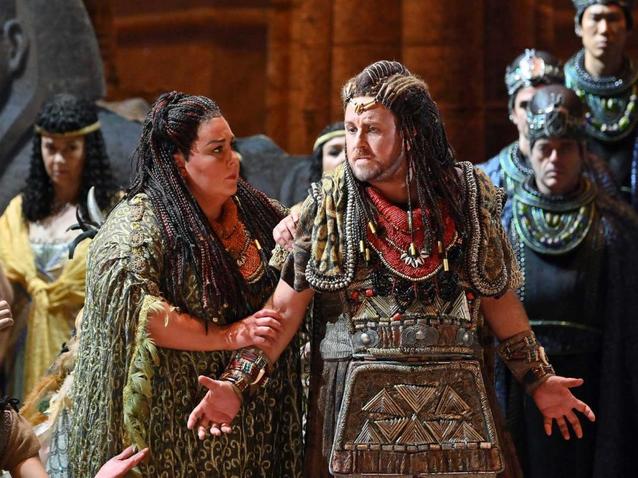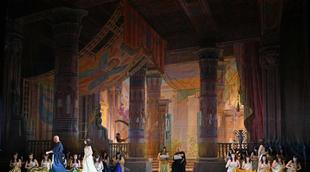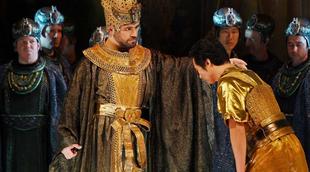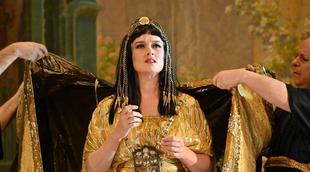 © A. Bofill
© A. Bofill
Aida - the opera which with over 450 performances is by large the most performed at Liceu - has come back once more to the Barcelonan theatre in a unique staging that belongs to the history of the theatre: the old paper set by stage designer Josep Mestres Cabanes (1898-1990).
Mestres Cabanes, master of perspective and scenography trompe-l’oeil, spent 8 years painting this set. This was premiered in 1945 and was used regularly in the theatre until the mid-60s. With the shifting orientations in the fields of theatre and opera scenography, these monumental 120 painted curtains representing 7 different scenes of the opera remained put away and forgotten in a storehouse outside Liceu. For this reason, this is the only complete set painted by Mestres Cabanes that survived the 1994 fire which destroyed the theatre.
In 2001, with a renewed sensitivity and bearing in mind that this set was part of the Liceu’s heritage, it was used again. It needed reinforcing and consolidating as well as adapting to the modern scenic machinery of the new theatre. New spotlights were needed in order to reproduce the soft lighting from 70 years ago as otherwise the modern spotlights would have burned the highly fragile paper.
This sumptuous and spectacular Aida set – which on one hand gives an authentic three dimensional sensation due to its impeccable perspective, and on the other hand, moved by the air currents from within the stage, oscillates reminding us that theatre is always an illusion, pure illusion – is the theatre’s life story. The set has now been restaged again, but this might be its last time as, unless it undergoes an in depth restauration, these old hand painted papers, created 75 years ago, will not endure many more performances.
Thomas Guthrie, a bold stage director with a significant background as a baritone – he sang Bach’s Cantatas under the baton of Sir John Eliot Gardiner for example – was in charge of the stage direction. Aware of working with historic materials and having to adapt to these, Guthrie showed a respectful work without giving up on bringing his own point of view as well. This was visually represented in two occasions at the beginning and at the end of the piece. The set was initially taken down and then at the end put up again, showing therefore the nakedness of the stage and achieving the necessary ‘Brechtian distancing’, reminding us that the dramatic truth is never about authenticity.
Musically, the night of the premiere was irregular. The percentage of debuting elements in the precision machinery which is – or should be – a theatrical performance has to remain low. Increasing it means dangerously heightening the risk level.
In this Aida, were debutants at Liceu: the conductor, Gustavo Gimeno; soprano Angela Meade, singing the role of Aida for the first time; Yonghoon Lee, the South Korean tenor on the role of Radamés; bass Mariano Buccino, as King of Egypt; and baritone Franco Vassallo as Amonasro, Aida’s father. Too many debuts for a premiere.
Gustavo Gimeno brought together well the orchestra and the singers, accompanied the singers prudently but didn’t obtain great orchestral shine. His work was good without being memorable. Angela Meade has a very beautiful voice for singing Verdi, she has a good higher and middle registers and offered certain greatly crafted pianissimi in the upper register. Her lyrical lines were soft and elegant and her performance was highly satisfactory. She is one of today’s best Verdian voices. However, Meade suffered a small vocal incident in the attack of the highest note in the role’s most well-known aria ‘O patria mia’. She probably had run out of breath in order to deliver it with sufficient assurance and very intelligently decided to omit it. A bar later, she resumed the singing and when those two repeated notes arrived in the repetition of the phrase she sung them flawlessly.
Clémentine Margaine sung very well the role of Amneris, Aida’s rival, a role that demands a very accurate effort administration since its most difficult part comes at the end and one has to arrive at it with some energy reserves. Kwangchul Youn was thoroughly convincing and confident in the role of Ramfis. Amonasro was interpreted with good vocal lines and beautiful voice, but without particular robustness by Franco Vassallo, and the role of the king was delivered correctly by Mariano Buccino.
The case of tenor Yonghoon Lee requires a special mention. The singer possesses a very powerful voice as well as good high notes and his tuning is good, but he was completely out of style in the role of Radamés. He constantly forced the projection with hard and uncontrolled attacks, the phrasing lacked beauty, the diction was poor, he almost always sang forte or fortissimo and moved suddenly to pianissimo as if there were no intermediary dynamics. The audience was benevolent and he even received courtesy applause, probably aimed more at the undoubtable braveness with which he faced the role than at the beauty of the interpretation.
The choir was very good and confident. The ballet, so important in Aida, received a new choreography, not at all traditional and a little extravagant, by Angelo Smimmo, inspired in capoeira and elements of contemporary dance which was generally well received by the audience.
Finally, it is worth mentioning that this spectacular production will be broadcast to more than 200 cinemas across the globe, most of them live, on the 22nd January. Unless a miraculous patron appears to sponsor the restauration of the set, this will probably be the last time that the set will be seen in action in this old and splendid painted paper Aida, which is a living relic of how opera was done a hundred years ago.
Xavier Pujol
Barcelona, 13th January 2020
Aida by Giuseppe Verdi. Mariano Buccino, bass. Clémentine Margaine, mezzosoprano. Angela Meade, soprano, Yonghoon Lee, tenor. Kwangchul Youn, bass. Franco Vassallo, baritone. Orchestra of Gran Teatre del Liceu. Choir of Gran Teatre del Liceu. Gustavo Gimeno, conductor. Thomas Guthrie, stage director. Angelo Smimmo, choreography. Josep Mestres Cabanes, stage designer. Jordi Castells, set adaptation and restauration. Franca Squarciapino, costumes. Albert Faura, lighting. Production of Gran Teatre del Liceu.
the 16 of January, 2020 | Print



Comments